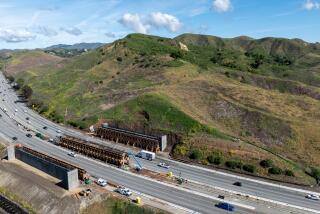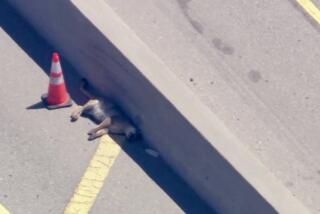Intersection Plan Is Turn for Better, Engineer Insists
Itâs a bit like trying to build a better mousetrap.
Ever since the traffic signal was invented in 1914, many a motorist has cursed while waiting at a red light. But try as they may, traffic engineers have been hard-pressed to devise a better way to regulate the growing gridlock at intersections.
Enter Belisaro Romo. The Mexico City-born transportation engineer, now a resident of Orange County, has a newfangled design that he boasts is the perfect solution for congested, big-city intersections.
Basically, Romoâs idea eliminates the traditional left turn lane, which often keeps a grumbling pack of motorists waiting while cars cut quarter-circles across an intersection and onto a cross-street.
Instead, Romo has left-turning motorists swing across the on-coming lanes--momentarily empty, with traffic from that direction stopped at a red light--a half block before an intersection--and roll down a special strip of pavement on the opposite side of a raised concrete median. When itâs time for the main wave of cars to rumble ahead, the left-turners are free to do the same, unfettered by the need to cross oncoming traffic.
While it all may seem like a blueprint for a pinball game, the design has caught the eye of traffic planners in Orange County. They are studying the concept with the notion that it might prove a practical addition to the countyâs âsuper streetsâ program, an ambitious plan to upgrade bustling thoroughfares such as Beach Boulevard and Moulton Parkway in an effort to ease congestion and improve traffic capacity.
As planners see it, the most palatable benefit is the elimination of the typical four-phase intersection, with signal lights permitting left turns, then through traffic, followed by the same sequence on the cross street. With Romoâs design, only two signal phases would be needed, with through traffic and left turners going at the same time on each street.
âIt it works, I think weâll build it,â said Arya Rohani, special projects manager for the Orange County Transportation Commission. âBut itâs going to be a while before we get to that comfort level and can trust it.â
Romo has also pushed his idea in Phoenix, San Diego and New York, where officials expect to decide in about a month whether they will use the design to upgrade an intersection at the foot of the Brooklyn Bridge.
Though all the ruminations and calculations have yet to be done, Romoâs design has some alluring features for traffic engineers. Most notably, his intersection could be built faster and cheaper than the ramps and âflyoverâ overpasses that are the most viable alternative, Romo contends.
But some transportation experts remain dubious, questioning just how user friendly this new-age intersection will prove. If the average motorist canât adapt to Romoâs design, they suggest, it could create safety problems that donât exist today.
âTheoretically, it works well,â said Paul Singer, Anaheimâs traffic engineering chief. âBut public acceptance may be extremely difficult to achieve. It may be frightening for some motorists. I really wonder about the confusion that might be caused, with drivers having to start their left turn some 300 feet ahead of an intersection.â
County transportation experts, meanwhile, worry that the design might prove to be much more expensive than anticipated because of a need to buy up land to expand the right of way for the broad series of lanes Romoâs plan requires.
Even those who are bullish on the idea note that it could confound motorists. At the very least, they say, a plethora of street signs will be needed to help drivers find their way through the turn lanes. And the timing of the various signal lights will have to be perfected with pinpoint accuracy to make the intersection work well.
Moreover, Orange County officials have yet to conduct the sort of in-depth computer analysis needed to determine if the intersection would prove a success or a flop in the real world. Steven Hogan, the countyâs transportation division manager, said he hopes to have some results by yearâs end.
âIf it works, we may give it a shot,â Hogan said. âBut we want to make sure that the gains you see at one intersection arenât taken away at another.â
The designâs biggest booster, of course, is Romo himself. He hardly minces words while promoting the concept, making it sound like the next best thing to striped lanes.
âThis is my best hand,â he says of his intersection design. âIâm very proud of it. This is the culmination of my career, my life. All I know is here, in this simple concept.â
The son of a transportation planner in Mexico, Romo studied architecture in his homeland before moving to New Zealand for engineering school. He has been a transportation consultant for about 20 years, mostly in South America and Mexico, he said.
Roughly two years ago, he came north to market his new concepts, which include a singular design for a system of freeway overpasses that Romo contends is a vast improvement on the cloverleaf.
Romoâs main pursuit, however, is to improve the design of city streets, a branch of transportation engineering he believes has been neglected. He originally devised his new concept in hopes of selling it to the city of Irvine for use at the intersection of Jamboree Road and Barranca Parkway, but the city never went for the idea.
âEveryone is a little bit afraid to try something new,â said Herman Kimmel, president of a Newport Beach transportation engineering and a booster of Romoâs design. âEveryone is just holding back. They donât want to be the first. They donât want to be the ones who stick their neck out.â
But it may not be long before someone does. Authorities in New York City are seriously investigating Romoâs concept for use on an intersection at the foot of the Brooklyn side of the famous bridge leading to Manhattan, according to Joel Friedman, deputy assistant commissioner for traffic operations in the city.
With more than 15 million square feet of office, residential and commercial high-rise space scheduled to be completed in Brooklyn by 1993, city officials are eager to find a remedy for traffic problems at the entryway to the Brooklyn Bridge, he said. They originally planned to build a $16-million underpass to speed traffic, but have since turned their gaze on Romoâs concept, which boasts a $2-million price tag, as a more cost-effective solution.
âWhen I first looked at it, I thought it was good but really weird,â Friedman said. âItâs different than anything Iâve ever seen, but I think it could work. . . . New York has never been afraid to take a chance and try something new.â
But first the plan must pass tests to determine that it will improve air quality in the intersection, a key point since the entryway has been listed as a smog-choked âhot spotâ by environmental agencies, Friedman said.
Romo is confident that his design will be an environmental boon for New York and other cities. Cars belch out pollution most when they sit idling in traffic or at stop lights, he noted, and his design would keep cars moving.
Orange County transportation authorities agree that it all looks dandy on graph paper, but they are withholding judgment until they see more technical analysis.
âItâs a good idea,â said Rohani of the County Transportation Commission staff. âIâm glad someone is thinking. The guy has put a lot of work and time into this. But we canât make any commitments until we see some more numbers and studies done.â
THE INTERSECTION OF THE FUTURE? 1) CROSS TRAFFIC: Cross traffic in a standard pattern. Vehicles making a right turn proceed without stopping. 2) U-TURNS: Vehicles make U-turns as cross traffic is moving. They will be able to turn without interfering with the flow of traffic. 3) LEFT TURN POCKET: Vehicles that have lined up in a turn pocket about half a block from the intersection wait for a green light to swing into a special left-turn lane. 4) LEFT-TURN LANE: While cross traffic is moving, left-turn vehicles continue down the special lane toward the intersection. 1) CROSS TRAFFIC: As left-turn traffic approaches the intersection, a signal light bring cross traffic to a halt. 2a) THE LEFT TURN: Signal lights are synchronized so those making left turn get a green light as they approach the intersection. They are able to turn left without interfering with through traffic. 2b) THROUGH TRAFFIC: Unimpeded by left-turning motorists, through traffic is able to proceed without any delay. In theory, the intersection increases traffic flow and reduces vehicle air pollution while costing less to construct. Several cities are studying the feasibility of the intersection.
More to Read
Sign up for Essential California
The most important California stories and recommendations in your inbox every morning.
You may occasionally receive promotional content from the Los Angeles Times.










